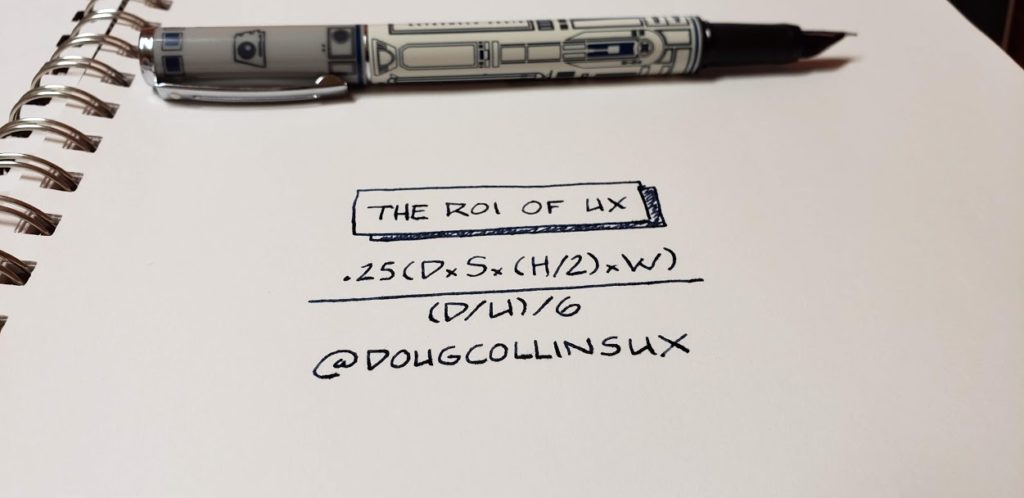This piece on the ROI of UX by Doug Collins, Editor, UXNewsMag.com
The value of User Experience is undeniable.
TurboTax sets itself apart with it. Netflix killed Blockbuster with it. Apple built an empire on it.
The tech industry as a whole is finally catching on the to value of UX and design thinking. Many smaller companies and startups, however, remain reluctant to invest.
As a result, larger and more successful companies are leading the way. Some of the top tech companies in the world have dramatically reduced their developer-to-designer ratios over the past decade. IBM, for example, reported a 72:1 ratio in 2007. They’re down to 8:1 as of 2017, with plans to hire even more.

The role of design and designers in technology has changed. And UX in particular has sparked the revolution.
General Assembly has it listed as one of the three most promising careers for 2020. One blog has estimated 150,000 open UX jobs worldwide.
Others report vacuum of available talent in the UX market.
However, for small companies and startups the question of hiring a UXer remains one of financial risk. UX can appear costly, with the price tag for a single UXer running north of $115,000/year in some markets.
Any sizable investment has the ability to make or break a company at this stage. An unknown value proposition makes shelling out the dough even more difficult.
But UX more than pays for itself. The math doesn’t lie.
The Equalizer: The ROI of UX on Development Teams
Proving the Return on Investment (ROI) of UX has always been a tricky subject. It makes sense that a more usable and pleasant experience should lead to higher conversion and more return visits.
But mathematically proving the value of good UX design is no easy task.
It’s impossible to create an equation that shows the total ROI of UX for all industries. Industry differences in product and service offerings make it too complex.
The value of UX design is universally provable in one area. UX substantially mitigates the time development teams spend fixing broken software.
A 2005 study from the IEEE listed the 12 most common reasons software development projects failed. The report estimated developers spent 50% of their time fixing broken software.
The study also found that solid UX practices could mitigate or eliminate 1/4 of those reasons. This suggests that a good UX team can cut 1/8th of developer lead time in projects.
This also gives the basis for an imperfect formula to estimate the ROI of UX on the development cycle alone.
Figuring Out the Math

Brace yourself. Things are going to be mathy here for minute.
Here’s the formula, and a quick explanation.
Take the number of developers and multiply that by their average hourly salary. That returns the cost of a development team per hour.
Take that number and multiply it by the average number of hours worked in a week per developer, halved. This represents the 50% of weekly time that developers spend re-working failed software.
Multiply that by the average number of weeks worked per developer per year. This is the total cost of failed software projects to a company.
We then multiply that number by .25. This represents that solid UX principles can mitigate one quarter of that re-work.
The divisor is an equation that assumes an ideal 6:1 developer-to-designer ratio. TechCrunch’s recent figures on hiring supports this as the ideal ratio.
The equation, when written out, looks like this.
.25(D*S*(H/2)*W)/((D/U)/6)
D = Number of Developers
S = Average Hourly Salary per Developer
H = Average Number of Hours Worked per Week per Developer
W = Average Number of Weeks Worked per Developer
U = Number of UX Professionals
Processing the Figures
Let’s examine things from a practical perspective. We’ll use Denver, my hometown, as the example.
The average software engineer salary (not including benefits) in Denver is $98,477/year. This equates to $47.34/hour. We’ll add on another $20ish/hour in benefits and bonuses. This gives us an estimate of $70/hour total compensation.
We’ll assume a 40-hour work week and three week’s vacation for each developer. We’ll also assume a team of six developers and one UX designer.
If we plug the numbers into the equation, this is what it looks like:
.25(D*S*(H/2)*W)/((D/U)/6)
D = Number of Developers = 6
S = Average Hourly Salary per Developer = $70
H = Average Number of Hours Worked per Week per Developer = 40
W = Average Number of Weeks Worked per Developer = 49
U = Number of UX Professionals = 1
.25(6*70*(40/2)*49)/((6/1)/6) => .25(411,600)/1 => $102,900
That means the impact of hiring a single UXer to work on a team with six developers in Denver is about $102,900. That’s already more than the average UX Designer Salary in Denver of $87,505.
Remember: these figures take into account only the ROI of UX on developer’s time spent re-working failed software.
The Bottom Line
The implication here is huge. Any properly-staffed UX team will more than pay for itself in terms of ROI on one narrow piece of the business. This means that even if a UX team has zero impact on retention, conversions, page abandonment, or other KPIs, building a UX team is a zero-risk investment.
And the research supports that UX will have an immense impact on these figures. One oft-quoted study from Forrester claims a return of $2 – $100 for every $1 spent on user experience investments. Others show solid UX design is proven to consistently decrease customer support needs, increase sales, and increase conversions.
Apple CEO Tim Cook is famous for saying “Most business models have focused on self interest instead of user experience. [The user experience problems] are the ones we solve to solve.”
To put it a different way, those who are already onboard are already reaping the profits. Those who aren’t yet on board now face a choice: embrace the power of user experience, or die at the hands of competitors who have. What choice has your business made?
About Doug Collins

Doug Collins is a UX professional with more than 10 years experience designing interfaces for companies and organizations of all sizes. He is the Editor of UXNewsMag.com.
@DougCollinsUX | DenverUXer.com| LinkedIn.com/in/DenverUXer
More from Doug Collins
What’s in a Name? UX Job Titles Explained
Stepping Up Your Game: Updating Your UX Skills





👏👏👏👏👏